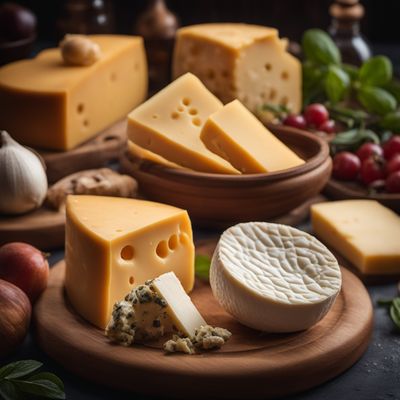
Ingredient
Cheese, tronchon
The Art of Tronchon: A Savory Cheese Delight
Tronchon cheese is a semi-hard cheese with a pale yellow interior and a natural rind. It has a smooth and creamy texture that becomes crumbly as it ages. The flavor is nutty, slightly tangy, and has a hint of earthiness. Its appearance is rustic and irregular, with a shape that resembles a truncated cone.
Origins and history
Tronchon cheese originated in the Aragon region of Spain and has a long history dating back to the 13th century. It is named after the town of Tronchon, where it was traditionally made by shepherds. This cheese holds cultural significance in Spain and is often enjoyed as a part of traditional Spanish cuisine.
Nutritional information
Tronchon cheese is a good source of calcium, protein, and vitamin B12. It also contains moderate amounts of fat and sodium. A 1-ounce serving of tronchon cheese provides approximately 100 calories.
Allergens
Tronchon cheese may contain lactose and is not suitable for individuals with lactose intolerance or milk allergies.
How to select
When selecting tronchon cheese, look for a cheese that is firm to the touch with a slightly springy texture. The rind should be intact and free from any mold or discoloration. Opt for cheeses that have been aged for at least three months for a more pronounced flavor.
Storage recommendations
To maintain the freshness and quality of tronchon cheese, store it in the refrigerator in its original packaging or wrap it tightly in wax paper or aluminum foil. Keep it away from strong-smelling foods to prevent flavor absorption. Consume within 1-2 weeks of opening for the best taste.
How to produce
Tronchon cheese is typically produced by using cow's milk, although some variations may include a blend of cow's, sheep's, and goat's milk. It requires specialized cheese-making equipment and techniques, making it more suitable for experienced cheese makers.
Preparation tips
Tronchon cheese can be enjoyed on its own, paired with fruits and nuts, or used in various dishes such as salads, sandwiches, and gratins. It melts beautifully, making it an excellent choice for fondues and cheese sauces.
Culinary uses
Tronchon cheese is commonly used in Spanish cuisine, particularly in dishes like Tronchon cheese omelets, Tronchon cheese croquettes, and Tronchon cheese-stuffed peppers. It is also a popular choice for cheese boards and tapas.
Availability
Tronchon cheese is primarily produced in the Aragon region of Spain, particularly in the towns of Tronchon and Teruel. It is also available in select gourmet cheese shops and online retailers.
More ingredients from this category » Browse all

Cheese, marechal
The Bold and Robust Marechal Cheese

Cheese, danbo
The Danish Delight: Exploring the Savory World of Danbo Cheese

Cheese, cheshire
The Quintessential British Cheese: Exploring the Delights of Cheshire Cheese

Cheese, colby
"Colby Cheese: The Creamy Delight with a Mild Twist"

Cheese, morski
The Oceanic Delight: Exploring the Unique Flavors of Morski Cheese

Cheese, esrom
The Danish Delight

Cheese, turunmaa
Turunmaa: The Finnish Delight

Cheese, cantal
The Versatile Delight: Cantal Cheese

Cheese, carrigaline
Irish Delight

Cheese, appenzeller
The Swiss Delight: Appenzeller Cheese

Cheese, nisa
The Hidden Gem of Cheeses: Nisa, a Delightful Culinary Treasure

Cheese, chimay
The Belgian Delight: Chimay Cheese